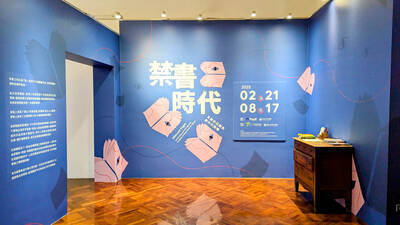A group of young Japanese tourists oohed and ahhed as svelte acrobats in traditional Chinese costumes did flips, splits and formed human pyramids while spinning plates. Two Western visitors arrived late for the show, just in time to see another acrobat execute complicated gymnastic maneuvers as he carefully stacked eight chairs on top of one another while simultaneously climbing them until he could nearly touch the theater’s ceiling.
Although Canadian performance troupe Cirque du Soleil’s ongoing 56-show run of Alegria in Taipei sold out months in advance — prompting the company to add Taiwan to its regular Asian touring schedule — the homegrown Chinese Acrobatic Troupe of the National Taiwan College of Performing Arts (國立台灣戲曲學院) finds itself relying on foreign tourists and students to fill seats at its twice-weekly shows in Neihu.
Founded in 1990, the Chinese Acrobatic Troupe is Taiwan’s first and only professional acrobatic company. It currently employs about 40 people, each of whom boasts at least 10 years of experience performing Chinese variety art. As a national theater company partially subsidized by the government, the troupe has traveled to more than 50 counties and performed in front of packed houses during three tours of Canada and the US between 2000 and 2005. In China, it has gone head-to-head against Chinese companies and won trophies at acrobatic art competitions.
Back home, however, the Chinese Acrobatic Troupe enjoys sparse attention from Taiwanese audiences, in part because of lack of money for publicity but also due to the perception that its shows are too traditional. The troupe began to embrace change three years ago, after the government reduced funding, adding non-traditional elements such as storylines to its shows, hiring theater directors and introducing a large-scale annual production in a bid to increase local interest.
“We were known as a Chinese variety art troupe performing traditional acrobatic routines,” said Liang Yueh-ying (梁月孆) who has been the troupe’s director for the past five years. “But now we are adding theatrical elements [to our repertoire] to become a performance art group.”
In 2005, the Chinese Acrobatic Troupe began experimenting with different styles and started working with theater directors such as France’s Philippe Goudard.
For its latest yearly production, Love Rhapsody (逗囍狂想曲), the crew of acrobats teamed up with experimental theater director Wang Jia-ming (王嘉明) to tell the story of a romance between a little boy and a little girl. Love Rhapsody will be staged at Metropolitan Hall (城市舞台) on Feb. 4 and Feb. 5 and is scheduled to tour to Keelung and Hsinchu in April and May.
Wang has given the production an almost surrealist feel by playing with concepts of time and space. Love Rhapsody also features dreamlike fantasy sequences and whimsical characters including a magician and bicycle-riding angels.
Liang said she hopes the media hype surrounding Cirque du Soleil’s Taiwan tour will fuel interest in Love Rhapsody, although she noted that it seems to have yet to influence attendance at the troupe’s weekly shows in Neihu.
Lo Fei-hsiung (羅飛雄), the troupe’s art director and also an accomplished magician, bemoans the difficulty of nurturing and holding on to young talent in an art that has long been overlooked and marginalized.
“How many stage directors specializing in the acrobatic art do we have in the country?” said Lo, who has worked with the troupe for the past 18 years. “None.” Acrobats with 40 years of experience can’t find teaching jobs at universities, he noted. Such jobs, he said, go to students who spend two years abroad to obtain a master’s degree from a foreign university.
Veteran acrobats like Ku Su-ling (古素玲) have devoted their entire lives to studying Chinese variety art and, later, performing with the troupe.
Admitted to acrobat school at the age of 10, Ku and her classmates would start their morning training at 6:30am, enjoy a short breakfast break at around 8am, then continue practicing until noon.
Last September, after two decades in the business, Ku fell from a human pyramid during a show. She injured her spine and will be unable to perform for at least six more months.
“We get hurt quite often,” she said, noting that two junior performers recently received had their knees replaced with prosthetic joints.
Although it takes years for acrobats like Ku to hone their skills, master old stunts and invent new routines, most can only look forward to a relatively short life as an artist on stage, and they leave with little recognition and few career prospects.
“My heart aches to see a 40-year-old acrobat who can’t jump or flip any more,” Lo said.
The Chinese Acrobatic Troupe of the National Taiwan College of Performing Arts does demonstrations of traditional Chinese variety art with elements of contemporary theater each week at 10am on Mondays and Thursdays at Bihu Theater (碧湖劇場), 177, Neihu Rd Sec 2, Taipei City (台北市內湖路二段177號). The program changes every two months. Groups of more than 30 people are advised to reserve space in advance by calling (02) 2796-2666 X1631 or X1634. Tickets cost NT$400, or NT$200 for students.

There is a Chinese Communist Party (CCP) plot to put millions at the mercy of the CCP using just released AI technology. This isn’t being overly dramatic. The speed at which AI is improving is exponential as AI improves itself, and we are unprepared for this because we have never experienced anything like this before. For example, a few months ago music videos made on home computers began appearing with AI-generated people and scenes in them that were pretty impressive, but the people would sprout extra arms and fingers, food would inexplicably fly off plates into mouths and text on

On the final approach to Lanshan Workstation (嵐山工作站), logging trains crossed one last gully over a dramatic double bridge, taking the left line to enter the locomotive shed or the right line to continue straight through, heading deeper into the Central Mountains. Today, hikers have to scramble down a steep slope into this gully and pass underneath the rails, still hanging eerily in the air even after the bridge’s supports collapsed long ago. It is the final — but not the most dangerous — challenge of a tough two-day hike in. Back when logging was still underway, it was a quick,

From censoring “poisonous books” to banning “poisonous languages,” the Chinese Nationalist Party (KMT) tried hard to stamp out anything that might conflict with its agenda during its almost 40 years of martial law. To mark 228 Peace Memorial Day, which commemorates the anti-government uprising in 1947, which was violently suppressed, I visited two exhibitions detailing censorship in Taiwan: “Silenced Pages” (禁書時代) at the National 228 Memorial Museum and “Mandarin Monopoly?!” (請說國語) at the National Human Rights Museum. In both cases, the authorities framed their targets as “evils that would threaten social mores, national stability and their anti-communist cause, justifying their actions

In the run-up to World War II, Admiral Wilhelm Canaris, head of Abwehr, Nazi Germany’s military intelligence service, began to fear that Hitler would launch a war Germany could not win. Deeply disappointed by the sell-out of the Munich Agreement in 1938, Canaris conducted several clandestine operations that were aimed at getting the UK to wake up, invest in defense and actively support the nations Hitler planned to invade. For example, the “Dutch war scare” of January 1939 saw fake intelligence leaked to the British that suggested that Germany was planning to invade the Netherlands in February and acquire airfields